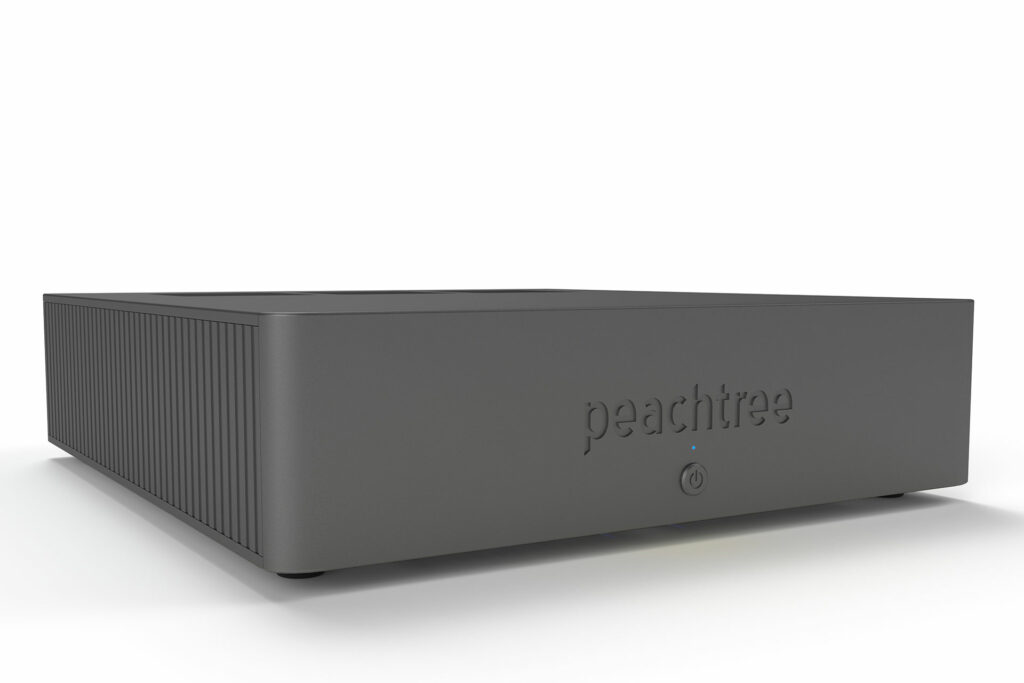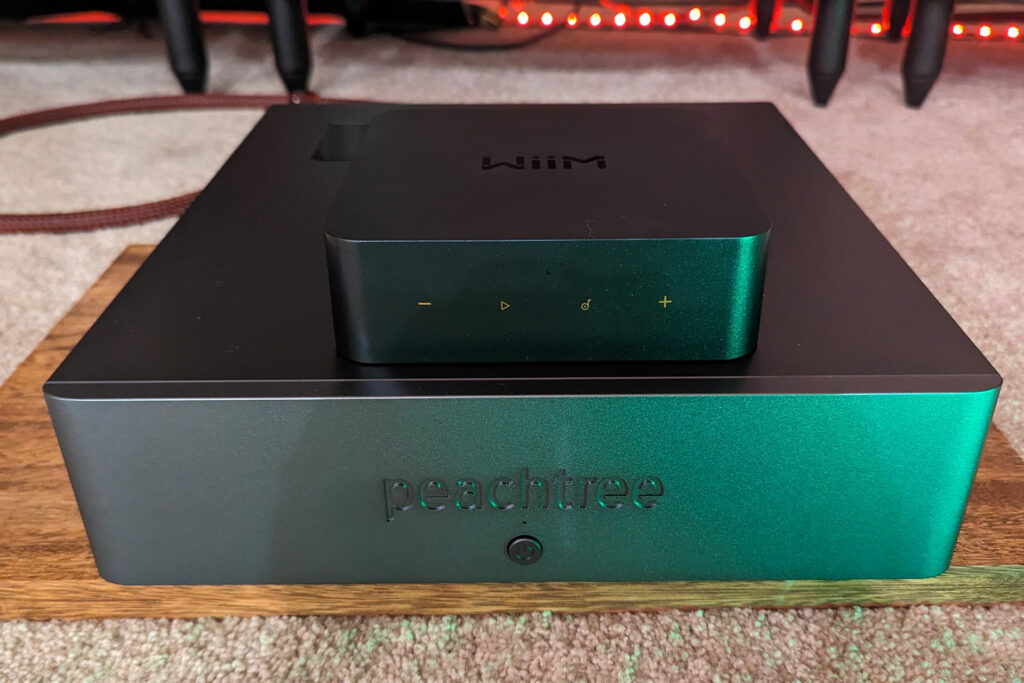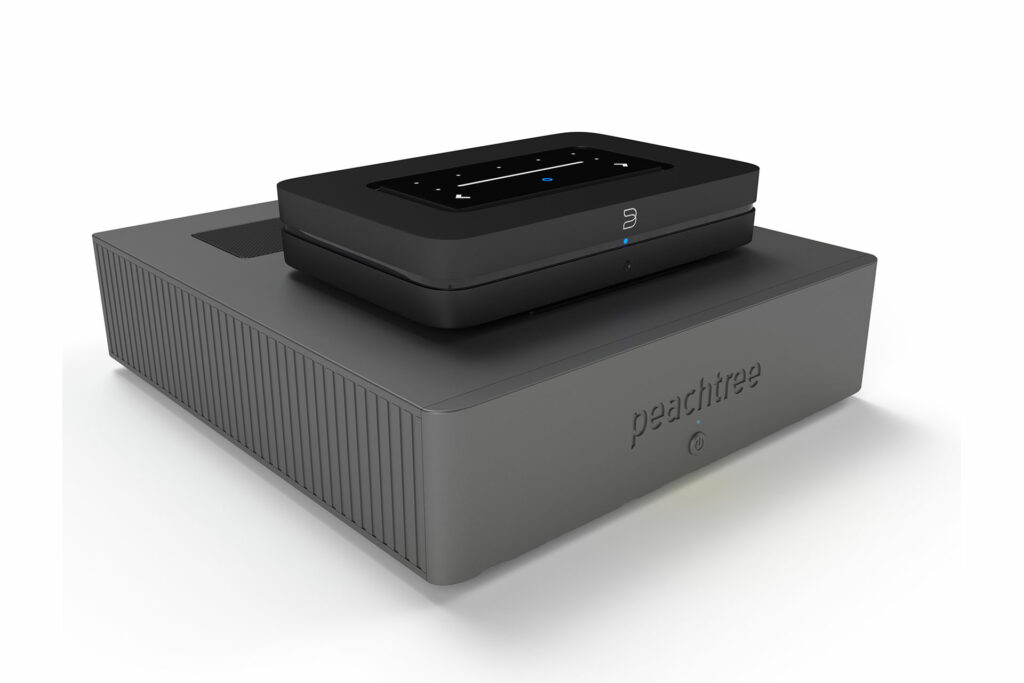I have been fortunate enough to experience GaN amplification since it first dropped into the audiophile world about five years ago. I have even replaced a trusty Parasound A21+ amplifier) that was in my audiophile gear collection for over a decade with an AGD Tempo di GaN $5,500 amplifier (read my review here). This new crop of Class-D “switching amps” (don’t call them “digital amps,” as that is technically incorrect) are total game-changers in ways that the first digital amps from 20 years ago simply were not. Today’s Class-D amps, be they Gallium Nitride (GaN), Hypex chip, Pascal chip or any other new semiconductor-based amps, that offer comparable performance with the most high-end audiophile amps are smaller, less expensive, use very little power and create practically no heat. These new amps are light and don’t need classic amp design elements like gigantic, heavy heat synchs, as most Class-D amps are 90 percent efficient or higher when it comes to AC power. These amps challenge all that many of us veteran audiophiles know about what makes an excellent amp, meaning a low-cost, low-heat, low-energy-use amp that can take on (and beat) some of the best and much more expensive Class-A and tube designs without any of the maintenance or issues that come with the aforementioned and much-lauded audiophile amps. These are exciting times to be an audiophile, without question, even if you have a smaller budget.

The $1,299 200-watt GaN 1 power amp from Peachtree Audio is a unique application of Gallium Nitride technology in a power amp, as it is designed to work specifically with a source with a variable output, be it a silver disc-spinning device or one of today’s best yet affordable HD music streamers. 200 watts of GaN power will drive nearly any modern audiophile loudspeaker out there and, for $1,299, that is saying a lot. Is this some brute force, newcomer amp that is a little rough around the edges, or can it deliver on the promise that it can sound an awful lot like the best amps from Switzerland without the Patek Philippe sized price tag? This is what we are here to find out …
What Makes the Peachtree Audio GaN 1 Amp So Special?
- There is zero feedback within the amplifier circuitry of the GaN 1, which preserves fidelity. By design, most traditional amplifiers need to take a tiny bit of the signal after amplifying it and feed it back into the signal path before the amplification section to make the amplifier stable. That’s just how many traditional amps work, but doing so can lower the fidelity of the sound a little bit. Peachtree has gone the more difficult design route to assure feedback is not required. Amp geeks like me are starting to rejoice.
- The Peachtree Audio GaN 1 has a monstrous 400-watt regulated power supply. Every manufacturer of GaN technology I have spoken to, without exception, enthusiastically stresses the importance of the power supply for GaN amplifiers. Peachtree Audio is no exception and, thanks to the great engineering of the power supply, the GaN 1 will output 200 watts per channel from a 10.8-pound component with, in effect, no heat.
- There is no DAC in the GaN 1 amplifier. Switching-type amplifiers require a DAC before the switching amplifier stage, since the amplification is done in the digital domain. Due to the GaN 1’s purpose, an internal DAC is not required, and the why is simple: the less there is in the signal path of the sound, the better fidelity you get. Less feedback is good too and the Peachtree Audio GaN 1 uses their own algorithm that reportedly creates less feedback than other Class-D amps that use a comparator type solution. This is just a little bit more clean and high performance and all of those little details often adds up to big improvements in audiophile components.
- The SPDIF input of the GaN 1 supports up to 24-bit/192kHz high-resolution digital sources. Today’s best streaming services can deliver on this in the digital domain, thus making audiophile vinyl and nearly every other silver disc a bit low-resolution in comparison. The Peachtree GaN 1 is up to any of these musical playback challenges, including the most high-octane audiophile sources.
- The GaN 1 has a solid build that any audiophile would be proud to display. To dismiss the importance of issues like pride of ownership and/or the concept of “audio jewelry” would be to lack an understanding of how products get sold, as well as loved, over time.

Why Should You Care About the Peachtree Audio GaN 1 Amplifier?
The concept of a “Power DAC,” or a DAC that directly powers floorstanding loudspeakers, has been tossed around since digital audio has come on the scene. Like many early digital concepts, poor initial execution led many away from the Power DAC, and the whole kaboodle got tabled. Peachtree Audio has brought back this concept in force with the Gan 1 amplifier.
The Peachtree Audio Gan 1 acts as the power in the term Power DAC. The user just needs to add their own digital source with a variable output digital SPDIF output. This direct digital configuration removes complexity from the signal path and has significant advantages in terms of simplified connectivity and improved fidelity. Peachtree Audio found that it was time to pull out the old concept of the Power DAC, blow off the now-irrelevant dust and reimagine it. Doing this would not be possible without GaN technology and Peachtree Audio’s keen engineering. If uniquely high performance and total system simplicity appeal to you, so will the Peachtree Audio GaN 1.

Some Things You Might Not Like About the Peachtree Audio GaN 1 Amplifier
- The GaN 1 is a one-trick pony in terms of an audiophile component. Peachtree Audio does not hide this fact, and is firm in their stated purpose for the GaN 1. With a lone digital coaxial input, the GaN 1 amplifier can only accept a variable digital input, and has zero room for any expansion, as you see with more expensive but comparable products from, say, NAD. The result of this simplicity in design is that the Peachtree Audio GaN 1 delivers far better fidelity than you might expect at $1,299. This high-value and high-performance proposition comes at the expense of the component’s singular purpose. For those needing more flexibility, for $1,999 Peachtree Audio offers their GaN400 amplifier, which doubles the power of the GaN 1 and provides traditional input options.
- If your variable digital source does not have a high-resolution volume control (24-bit, or 32-bit), you will hear the poor quality of the streamer through the Peachtree Audio GaN 1. This isn’t a problem with the GaN 1 and more about the sources which can sometimes be a little chintzy (see earlier comment about power supplies, but that’s not the only factor by a large margin). The Peachtree Audio GaN 1 will be your window to the audiophile source plugged into it. You don’t need to spend a fortune on a streamer to get HD output, but don’t assume that all streamers in the $400 to $600 (or much less) range are created equally, as they are not. Pick a good one.
- The Peachtree Audio GaN 1 amp is a non-standard size, like many other amps in this exciting new category. Certainly, the Peachtree Audio GaN 1 could be installed on a desktop, but it is realistically a bit large for such a location long-term. Make no mistake, the sonic performance of the Peachtree Audio Gan 1 makes it able to hang in a serious audiophile system, even if it isn’t the same standardized shape as other high-end audiophile components.
Listening To the Peachtree Audio GaN 1 Amplifier…
For my listening time with the GaN 1, I used the WiiM Pro Plus (review pending) streamer, and an older, up-sampling CD/HDCD disc player with variable digital output that was $2,999 back in 2008 by the now-defunct Jaton Audio. Peachtree Audio recommends, and even sells, the Bluesound Node Streamer with the GaN 1 amplifier, but I was not fortunate enough to get to hear the duo together. Greg Handy is reviewing the Bluesound Node, which will publish in early 2024, so stay tuned.
Lacking the recommended streamer was not a detriment, however, and while I was able to hear the lower bit-depth of the WiiM’s volume control, the Jaton CD player showed the Peachtree Audio GaN 1 can produce incredible fidelity and drive the snot out of just about any modern loudspeaker. The GaN 1 is a well-engineered amplifier, so is that last statement so surprising? I think not. I had several loudspeakers on hand, but primarily used the Polk Audio R200AE, the Sonus faber Lumina V, and even tinkered way outside the GaN 1’s comfort zone with PSB T800 loudspeakers (read my review here).
Fighting all Generation X cliches, I own over 900 CDs in my collection today. I was pleasantly surprised when thumbing through to find my 1994 copy of G. Love and Special Sauce’s self-titled album. “Eyes Have Miles” is a laid-back song that, for me, hits G. Love’s soulful, lyrical, and truly unique sound right on the head. To top it off, this recording presents as if recorded in a small studio without a whole lot of studio voodoo or over-processing. The Peachtree Audio Gan 1 has an incredible, effortless soundstage that sounded very large in my room. The soundstage captured the feel of the small studio well, putting me right in front of the band. I believe the GaN 1 was capable of this level of staging because the heavy-hitting bass drum was punchy, solid and got out of the way of the upright bass that sang its fretless lines, etched in the soundstage.
Having firm control of a loudspeaker is a key aspect that separates good amps from great ones, and the Gan 1 falls in the latter category. This control presented the loose snare drum that rang like a bell with a long-lived decay. The jazz guitar was familiar and preserved as a key aspect of the sound that G. Love’s fans love to vibe to. Finally, the lyrical vocals that are reminiscent of hip-hop shone through with all the small but extremely important accents that injects power into the words of a hip-hop track. I really enjoyed this track on the GaN 1, which presented itself like a truly sophisticated high-fidelity amplifier, even driving small towers at jam-out levels.
A year after G. Love’s self-titled album hit the CD section of Strawberries Music stores and Circuit City, Sarah McLachlan released Surfacing. McLachlan’s greatest hit, “Angel,” resides at Track Five on her very angst-filled album. I am not sure any audiophile would admit they listen to “Angel” on a regular basis. I will just put it out there that it is a beautiful song for both lyrics and performance. The Peachtree Audio Gan 1 captured McLachlan’s voice with all of the smooth and delicate sweetness I have heard through more expensive amplifiers. The piano had weight and separation of the notes in every sullen chord, and the bass was strong and anchored the track as it should. There are subtle accents of cello, as well as other quiet audio effects, that can easily be lost in the sound on a less resolute system. The Peachtree Audio GaN 1 had no problem resolving the small details, as you would expect from a much more expensive power amplifier.
Does the Peachtree Audio GaN 1 Amplifier Have Any Resale Value?
The GaN 1 is for the audiophile who loves to stream. Vinyl lovers simply need to look elsewhere, if even a little higher in the Peachtree product lineup. Same goes for people needing to switch many different and varied other audiophile sources. This audiophile singularity limits the customer pool who may want to take it off your hands someday. However, the GaN 1 reminds me of the kind of audiophile product that might just become a cult classic. The overall cost isn’t high, but the performance is. As long as you don’t need to plug your DaySequerra tuner into your audiophile system, you likely are going to be okay here with the Peachtree Audio GaN 1 power amp.
Who Is the Competition for the Peachtree Audio GaN 1 Amplifier?
It is worth noting when trying to make a comparison between a unique product like the GaN 1 that there may be limited competition. These are a couple of options that I feel present a value that is similar in magnitude to the GaN 1.
$1,599 buys you into the entry level of the Orchard Audio Starkrimson (read the review) 150-watt GaN monoblock amplifiers (buy from Orchard Audio). I bring up the entry level of the Starkrimson GaN monoblocks, because Orchard offers several upgrades for them. The Starkrimson are more traditional amplifiers in the sense that they accept an analog input, thus don’t need a variable input like the Peachtree GaN 1 does. Much like the Peachtree Audio GaN 1, the Orchard Audio Starkrimson monoblock amps offer very high-fidelity performance, but in a smaller form that is little larger than a deck of cards. The GaN 1 may have the edge in terms of overall performance, but the Starkrimson GaN amplifiers have an allure that is similar to what many love about tube amplification. The major difference is: the Starkrimson does not suffer any of the downside of tubes.
The newly re-introduced Adcom GFA-555ms rings in at $1,395, and is based off an original Nelson Pass (of the world-renowned manufacturer Pass Labs) design. The Adcom GFA-555MS is a traditional class A/B amplifier that delivers 200 watts into four ohms. However, like the GaN 1, it is designed to easily drive complicated loudspeakers. My colleague, Eric Forst, just finished his review of the comparably-priced, more traditional amp.
While not a GaN amp, the Buckeye Amps NCx500 stereo amp (read the review) is priced at $1,095 and comes with over 375 watts of power for this low price. I have heard some Hypex amp in this early rollout of these Class-D products, but will get to spend more time with the Buckeye Amps NCx500 amp in the coming weeks, as Mike Prager is sending me his review sample, which he purchased. The power output is among the highest that I’ve seen from a modern switching amp since I reviewed the absolutely kick-ass AMPED America 2400 amp, which uses the Pascal chipset (like Jeff Rowland Design Group at $35,000) for $5,000.

Final Thoughts on the Peachtree Audio GaN 1 Amplifier
The Peachtree Audio GaN 1 offers a level of audiophile performance that well exceeds any reasonable expectations that come with the amp’s modest $1,299 price tag. I believe this important take on the amplification side of the Power DAC is blazing the path in terms of providing solutions for the upcoming generation of young audiophiles, who prefer music on demand and do not want the hassle of storing and using physical media, such as CDs or vinyl.
The audiophile world doesn’t often embrace change. That’s in our hobby founder’s DNA, but change is inevitable, and today’s Class-D amps demand that audiophiles rethink what they want and how much high maintenance factors into what they are willing to put up with from an audiophile power amp, be it biasing, changing tubes, dealing with heat, selling blood to pay for the AC bill, and so on. While simplistic in its approach, the performance of the Peachtree Audio GaN 1 is there and then some. If you can keep the scope of your system to just streaming, you’ve got an audiophile world-beater here when it comes to the Peachtree Audio GaN 1.




Regarding your comments on a “power DAC”, this is exactly what the Lyngdorf 3400 integrated amp does (and before that, the 2170). Plus a bunch of other stuff of course, it’s a full featured integrated amp.